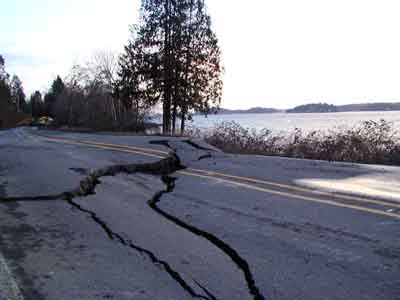13 April 2021–In the Cascadia subduction zone, medium and large-sized “intraslab” earthquakes, which take place at greater than crustal depths within the subducting plate, will likely produce only a few detectable aftershocks, according to a new study.
The findings could have implications for forecasting aftershock seismic hazard in the Pacific Northwest, say Joan Gomberg of the U.S. Geological Survey and Paul Bodin of the University of Washington in Seattle, in their paper published in the Bulletin of the Seismological Society of America.
Researchers now calculate aftershock forecasts in the region based in part on data from subduction zones around the world. But Cascadia intraslab earthquakes produce fewer aftershocks compared to others in subduction zones around the world. In Cascadia, these aftershock rates are lower by more than half that of the global average, Gomberg and Bodin concluded.
They also suggest that aftershock rates for Cascadia earthquakes generally appear consistent with a “clock-advance” model, in which the mainshock causes tectonically loaded fault patches to slip earlier than they would have under the normal background seismicity of the region.
Gomberg and Bodin decided to study the phenomenon further after recent intraslab earthquakes in Mexico and Alaska produced robust aftershock sequences. “This was startling because the lore in Cascadia was that intraslab earthquakes had puny aftershock sequences,” Gomberg explained, noting that in Cascadia three magnitude 6.5 to 6.8 intraslab earthquakes in 1949, 1965 and 2001 produced few to no aftershocks.

“Additionally, the USGS has begun to generate quantitatively estimated aftershock forecasts based initially on global patterns” she added, “and given these contrasting experiences, it seemed time to generate some objective numbers to base Cascadia’s forecasts on.”
The researchers analyzed earthquake catalogs produced by the Geological Survey of Canada and the Pacific Northwest Seismic Network from January 1985 to January 2018. Mainshocks that took place in the upper plate produced the most aftershocks, they found. Aftershock productivity was lowest for intraplate earthquakes in the Puget Lowlands portion of the subduction zone (which contains the Seattle metropolitan area), while aftershock rates were variable at the northern end of the zone near Vancouver Island and within the expected range for the southern end near Cape Mendocino.
The tectonic environment at each end of the subduction zone could help explain why aftershock production is higher there, the researchers said. Multiple plate boundaries meet in these areas, which could “concentrate stress, so more faults exist and are closer to failure than in other areas,” they noted.
The reasons why Cascadia aftershock production is so low compared to global rates are still unclear, but “one strong possibility would seem to be that temperature for the deeper slab earthquakes is a dominant controlling parameter,” said Bodin, noting that “the young, hot Juan de Fuca plate is being jammed beneath North America” in Cascadia.
The deeper the earthquake, the higher the temperatures, and the researchers did find that aftershock productivity decreases with depth, Bodin explained. “However, this is not so different than southern Mexico, where, as we noted, recent intraslab mainshocks have supported vigorous aftershock sequences.”
Gomberg and Bodin said their analysis was limited by the fact that seismicity rates in Cascadia are generally low and there are sparse data to constrain the location and depth of most earthquakes in the region. Methods that help researchers detect and locate smaller earthquakes could provide a better sense of overall aftershock rates and the physical processes that control them, they suggested.
